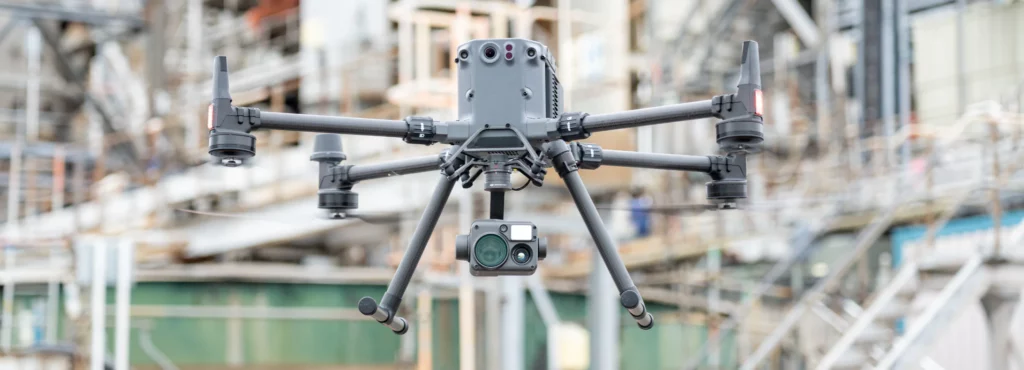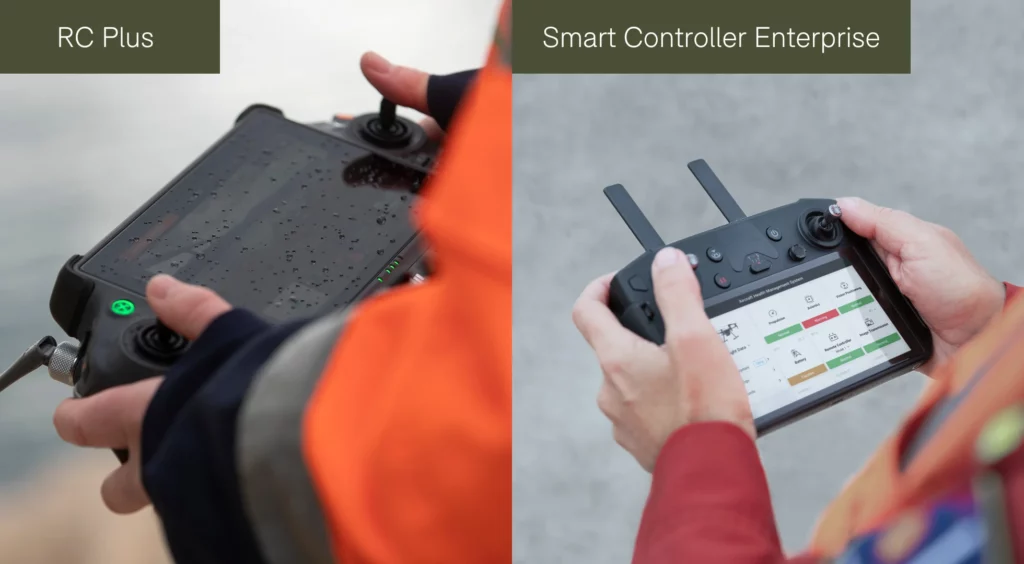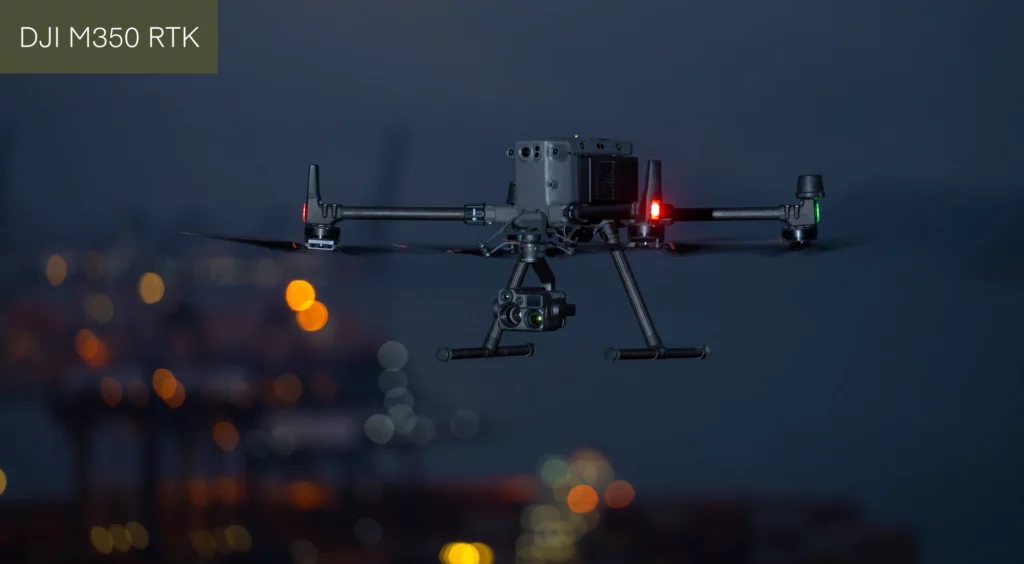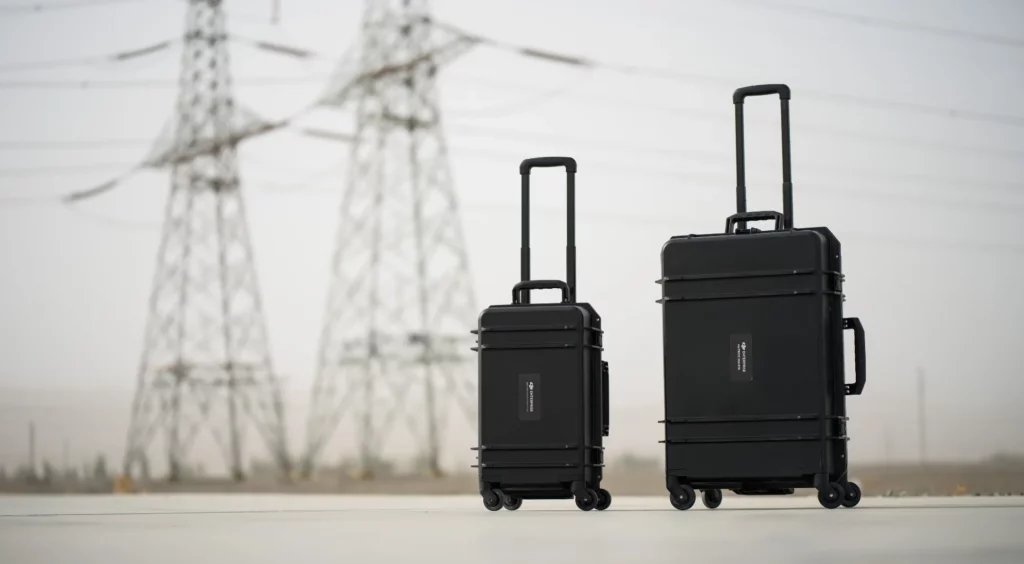Since its launch in May 2020, the DJI Matrice 300 RTK has become an indispensable tool for corporate drone operations. Three years later, DJI unveiled the Matrice 350 RTK, an improved version of its predecessor. It retains many basic components, but with significant improvements in key areas to further enhance the safety and experience of every flight.
Let’s take a look at these key upgrades and see how they improve the operation of the DJI M350 RTK compared with the DJI M300 RTK.
What are the main improvements of the DJI M350 RTK compared to the DJI M300 RTK?
The DJI M350 RTK retains many of the features of the DJI M300 RTK. For example, support for multiple payloads, long autonomy and robust, reliable design. In addition, there are now a number of key enhancements.

Below is a list of the eight main upgrades available for the DJI M350 RTK.
IP rating
In order to be as transparent as possible with consumers, and to protect them against marketing terms such as “water-resistant”, an international electrotechnical commission has introduced a system of particle intrusion protection (IP) ratings for electronic enclosures.
IP ratings are made up of two numbers, the first referring to solids and the second to liquids: for information, the numbers range from 0 to 6 for solids and from 0 to 9 for humidity, the higher the value, the greater the protection.
While the M300 RTK is rated IP45, the M350 RTK has been built with an improved IP55 tolerance. This means that the M350 RTK has better protection against solid objects, but both quadricopters have the same water resistance. They’re both rainproof, but not completely waterproof.
| DJI M350 RTK (IP55) | DJI M300 RTK (IP45) |
| Solid: Protection against solid objects larger than 1 mm (such as screws or wires). | Solids: Dust-proof (limited dust penetration permitted, not harmful). |
| Liquids: Protected against low-pressure water jets from all angles. | Liquids: Protected against low-pressure water jets from any angle |
In operational terms, both the M350 RTK and M300 RTK can operate in temperatures ranging from -20°C to 50°C. They also have a wind resistance of 12 m/s.
The controller
From launch, the DJI M350 RTK comes with the DJI RC Plus smart controller, which is an RC upgrade on the M300 RTK’s Smart Controller Enterprise.
However, the RC Plus is now compatible with the M300 RTK, following a firmware update, but the controller will have to be purchased separately for M300 RTK users.
The RC Plus controller, originally launched with the DJI M30 series, offers enhanced features over the Smart Controller Enterprise, including longer battery life, a larger screen and an IP rating.


The table below shows some of the main specifications between the two controllers.
| DJI RC Plus | DJI Smart Controller Enterprise | |
| Screen size | 7.02 inches | 5.5 inch |
| Screen brightness | 1,200 cd/m2 | 1,000 cd/m2 |
| Battery life | Internal battery: 3.18 hours ; Internal + external battery: 6 hours. | Internal battery: 2.5 hours ; Internal + external battery: 4.5 hours. |
| IP rating | IP54 | No |
| Operating temperature | -20°C to 50°C | -20°C to 40°C |
| Support for two operators | Yes | Yes |
| In the box | Included with DJI M350 RTK. Available separately for DJI M300 RTK operators. | Included with DJI M300 RTK. |
| Compatible drones | DJI M350 RTK DJI M300 RTK DJI M30 series DJI Inspire 3 (Inspire 3 version) | DJI M300 RTK |
An improved battery system
The DJI M350 features a brand-new battery system: the TB65 intelligent flight battery.
Although there is no increase in maximum flight time, both drones deliver up to 55 minutes (without payload). The M350 RTK’s TB65 batteries can withstand up to 400 cycles, compared with the 200-cycle life of the M300 RTK’s TB60 batteries.
This makes the TB65 a more efficient battery, capable of handling a greater number of cycles, and can be used twice as often as the TB60 before having to consider replacements. The M350 RTK also features a new TB65 intelligent battery station.
This new battery station also offers several charging modes:
- Standard mode (recommended for general users): each pair is charged to 100% in sequence (discharges automatically);
- Ready-to-fly mode (recommended for first responders): each pair is charged to 90% in sequence and maintained at 90% ;
- Storage mode (recommended for long-term storage): each pair is charged and maintained at 50%.
Note that TB65 batteries can be used with the DJI M300 RTK. The drone first requires a firmware update. Similarly, the TB60 batteries of the M300 RTK can be used with the M350 RTK. However, users must not mix and match batteries during flight.
The new arm lock indicator
One of the biggest safety improvements on the DJI M350 RTK is the addition of an arm lock indicator. The drone’s arm lock detection function prevents the risk of flying with unlocked arm sleeves. The M300 RTK, on the other hand, has no such functionality. The arm lock feature may not seem like a big leap, but it’s an important aspect of improving flight safety, and a welcome upgrade.
The improved FPV camera
The DJI M350 RTK and DJI M300 RTK have built-in FPV cameras, but the Matrix M350 RTK is listed as having a night vision FPV camera. This night vision camera clearly shows the environment and obstacles during night flight, guaranteeing a superior level of flight safety. The resolution of the M350 RTK’s FPV camera has also been increased, for greater image clarity.


The table below highlights the main specifications of the FPV camera on each drone.
| FPV camera specifications | DJI M350 RTK | DJI M300 RTK |
| Night vision | Yes | No |
| Resolution | 1080p | 960p |
| Field of view | 145° | 145° |
| Frame rate | 30fps | 30fps |
The new transmission system
The DJI M350 RTK uses the upgraded DJI O3 Enterprise, compared with the O2 Enterprise of the M300 RTK. The M350 RTK transmission system provides more powerful signals. This is embodied in the FCC regions, as DJI O3 Enterprise allows transmission up to 20 km, while the former O2 Enterprise facilitates up to 15 km with the M300 RTK.
The Matrice 350 RTK also features an improved anti-interference algorithm. It also features a four-antenna design. Two additional antennas have been added to the rear of the drone.
With two transmitting and four receiving antennas, the system will intelligently select the two optimal antennas for transmitting signals, while all four antennas receive signals simultaneously.
The powerful GNSS and RTK module
The DJI M350 RTK is equipped with a new GBSS chip for better signal reception and more satellites. Meanwhile, the new RTK module supports the L5 GPS band. This means that after activating RTL, the RTK would be repaired more quickly and easily.
The table below shows the M350 RTK’s extended GNSS frequency band support.
| GNSS frequency band | DJI M350 RTK | DJI M300 RTK |
| GPS | L1/L2/L5 | L1/L2 |
| GLONASS | L1/L2 | L1/L2 |
| Beidou | B1/B2/B3 | B1/B2 |
| Galileo | E1/E5 | E1/E5 |
Transport case update
Designed for easy transport, the DJI M350 RTK’s battery station and main housing are both equipped with wheels that move 360°. This may not seem like a great feature, but these wheels can make a big difference when you’re trying to transport a sturdy, less mobile M300 RTK box. The drone’s carrying case also features a double payload slot, enabling two payloads to be carried at the same time. It is also 31% smaller than the M300 RTK carrying case.


Key features: DJI M350 RTK versus DJI M300 RTK :
This table provides a quick comparison between the DJI M350 RTK and the DJI M300 RTK.
| DJI M350 RTK | DJI M300 RTK | |
| Dimensions (L x W x H) | Unfolded, without propellers: 810 x 670 x 430 mm Folded, with propellers: 430 x 420 x 430 mm (L×W×H) | Unfolded, without propellers: 810 x 670 x 430 mm Folded, with propellers: 430 x 420 x 430 mm (L×W×H) |
| Weight (with single cardan shaft down) | Approx. 6.47 kg (with two TB65 batteries) | Approx. 6.3 kg (with two TB60 batteries) |
| Maximum take-off weight | 9.2 kg | 9 kg |
| DJI Zenmuse payloads supported | Zenmuse H20 Zenmuse H20T Zenmuse H20N Zenmuse P1 Zenmuse L1 | Zenmuse XT2/XT S Zenmuse Z30 Zenmuse H20 Zenmuse H20T Zenmuse H20N Zenmuse P1 Zenmuse L1 |
| Third-party payload support | Yes | Yes |
| Maximum payload capacity | 2.7 kg Mount up to 3 payloads simultaneously | 2.7 kg Mount up to 3 payloads simultaneously |
| IP rating | IP55 | IP45 |
| Operating temperature | -20°C to 50°C | -20°C to 50°C |
| Maximum speeds | Vertical: 23 m/s Ascent: 6 m/s Downhill: 5 m/s | Vertical: 23 m/s Ascent: 6 m/s Downhill: 5 m/s |
| Maximum wind resistance | 12m/s | 12m/s |
| Maximum flight time | 55 minutes (without payload) | 55 minutes (without payload) |
| Controller | DJI RC Plus (in box) | DJI Smart Controller Enterprise (in box) DJI RC Plus (available separately, firmware update required) |
| Transmission system | DJI O3 Enterprise, 2T4R | O2 Entreprise, 1T2R |
| Object detection | 6 Directional detection and positioning | 6 Directional detection and positioning |
| CSM radar support | Yes (available separately) | Yes (available separately) |
| Arm lock indicator | Yes | No |
| FPV camera | FPV night vision camera 1080p/30fps 145° FOV | FPV camera 960p/30fps 145° FOV |
| Battery | TB65 Up to 400 battery cycles Hot swapping *DJI M350 RTK also supports TB60 batteries | TB60 Up to 200 battery cycles Hot swapping *DJI M300 RTK also supports TB65 batteries |
| Intelligent modes | Yes, including AI Spot-Check for automated inspections. | Yes, including AI Spot-Check for automated inspections. |
| GNSS frequency band | GPS: L1/L2/L5 GLONASS: L1/L2 Beidou: B1/B2/B3 Galileo: E1/E5 | GPS: L1/L2 GLONASS: L1/L2 Beidou: B1/B2 Galileo: E1/E5 |
| DJI FlightHub 2 compatible | Yes | Yes |
| Compatible with DJI Terra | Yes | Yes |
Compatibility comparison: DJI M350 RTK Vs DJI M300 RTK
The table below shows which accessories are compatible with the DJI M350 RTK and M300 RTK.
| M350 RTK + RC Plus | M300 RTK + RC Plus | M300 RTK + Smart Controller Enterprise | |
| Z30/XT2/XTS payloads | x | x | ✓ |
| Payloads H20/H20T/H20N/P1/ L1 | ✓ (Payload must be updated) | ✓ | ✓ |
| CSM Radar | ✓ | ✓ | ✓ |
| TB60 | ✓ | ✓ | ✓ |
| TB65 | ✓ | ✓ (The drone must be updated) | ✓ (The drone must be updated) |
| M300 RTK 2110 * propeller | ✓ | ✓ | ✓ |
| M300 RTK 2195 * propeller | ✓ | ✓ | ✓ |
| M350 RTK 2110s propeller * | ✓ | ✓ | ✓ |
| Propeller M350 RTK 2112 * | ✓ | ✓ | ✓ |
| M300 RTK universal joint support | ✓ | ✓ | ✓ |
| D-RTK 2 | ✓ | ✓ | ✓ |
* Mixing different propellers and batteries is forbidden.
In the meantime, this table shows the compatibility of TB60 and TB65 batteries with the corresponding battery stations. Please note that the TB60 battery and BS60 battery station must be updated with the latest firmware.
| Product | TB60 compatibility | TB65 compatibility |
| BS60 battery station | ✓ | ✓ |
| BS65 battery station | ✓ | ✓ |
In summary
The DJI M350 RTK is not a revolutionary product compared to the DJI M300 RTK. In many ways, this shows just how ahead of its time the M300 RTK was when it was released in 2020, and why it has become a key tool for drone programs around the world.
That said, by taking the basic elements of the M300 RTK and improving on them, DJI has developed an already powerful device.
At this stage, this probably means that current M300 RTK owners won’t feel compelled to rush out and replace their fleet with the DJI M350 RTK. At present, there’s still plenty of life left in the M300 RTK.
However, for operators looking to adopt the M300 for the first time, or for those wishing to add additional Matrice drones to their programs, the DJI M350 RTK is an option to consider.
To add the DJI M350 RTK to your drone fleet, including the associated drone training, please contact us!
